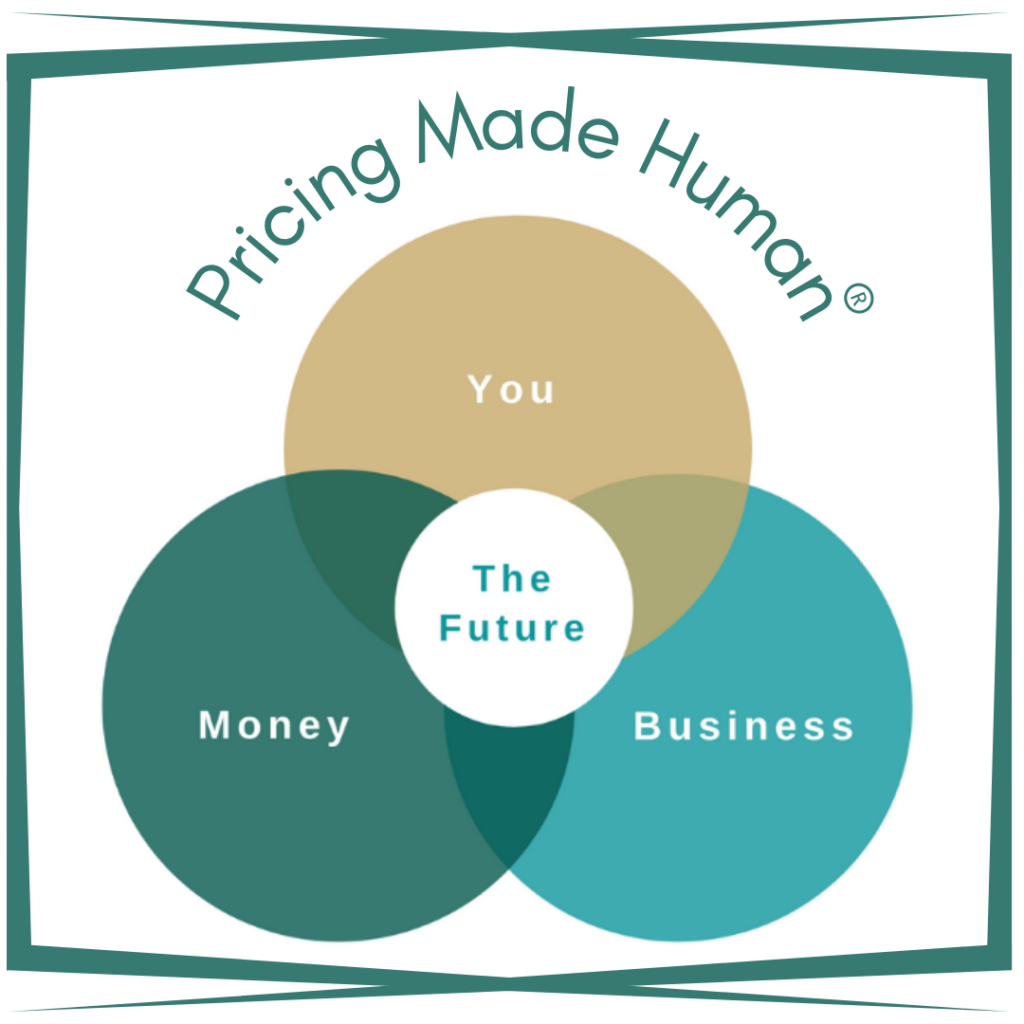Money is always in service to something else. It’s the “tool” by which you are able to “do, be, or have” what you either want more of or don’t currently possess.
Therefore, the prices you charge are also in service to something, too. Beyond your business’ sales, revenue, and profit.
Next week, I am sitting on a panel for what I am sure will be a wide-ranging conversation about women and money. Per the run-of- show, we’re scheduled to speak about several gaps. A few of them seem pertinent to the conversation we’ve been having these recent weeks as we talk about money and pricing – and gear up for the next Pricing Made HumanⓇ masterclass.
For the purposes of today’s piece, though, I’m going to focus on three gaps, which I’ve tweaked to fit our discussion:
- Time Gap
- Revenue and Income Gap
- Wealth Gap
Time Gap
If you’ve done the Financial Wheel exercise, you know one of the questions I ask is this, “If money were not an issue, what would you do differently with your time?”
Here are the answers I typically get:
- Work less
- Travel more
- Volunteer more
- Practice more wellness activities
- Focus on hobbies
The reasons behind these answers is what makes them unique to each person. However, the answers themselves don’t surprise me because I hear them so often.
And it turns out they also closely track with the findings of a survey conducted by The Workforce Institute at Kronos Incorporated and Future Workplace. Here’s what they found from surveying nearly 2800 employees worldwide:
- Spend time with family (44%)
- Travel (43%)
- Exercise (33%)
- Spend time with friends (30%)
- Pursue hobbies (29%)
Guess it doesn’t matter how you work – as an employee or an entrepreneur/small business owner – folks want more time!
Additional time that doesn’t simply come from managing your calendar, differently.
And based on how I phrased my question, “If money were not an issue…,” one can safely assume more money, and specifically more discretionary income, would do the trick.
Having more money would enable you to have more “free” hours in your day, week, month, or year.
Investing is one way to create more “free” hours. How you price your offers is another.
Do your current prices take into account the time gap you’re seeking to close?
Revenue/Income Gap
1979 is when data began to be collected comparing what women earned to men. And while the pay gap has narrowed over time, particularly in some industries, a gap still remains.
You are likely familiar with the wage gap stats below, as they tend to get a lot of media coverage in March during Women’s History Month:
- Asian women earn 90 cents for every dollar a white man earns
- White women earn 79 cents…
- Black women earn 64 cents…
- Native American women earn 57 cents…
- Latina women earn 54 cents…
The earnings gap exists for systemic reasons; it is not driven by educational or experiential differences. This is true whether you measure the gap between men and women, or between different groups of women.
The financial implications of this historical gap is tremendous. Especially when you account for earnings over a lifetime and the opportunity cost that comes with. Viewed this way, those cents quickly add up to millions…and then some.
Though disheartening, the fact of these stats need not be dispiriting.
You and I don’t have the power to change what has happened. But we sure as heck have the power to change what is and can happen moving forward.
We definitely have the power to stop under-charging and, thus, under-earning.
How? By talking more about money!
I’m not suggesting you blast your revenue or salary to the world. (I certainly don’t.) It’s prudent to be selective when it comes to what you disclose and to whom.
That said, I know talking about money with my clients has helped them get better with setting and quoting prices more commensurate with the value they deliver.
And I know I’ve gotten better at pricing my own scope of services, thanks to frank conversations with the coaches I’ve engaged, and my colleagues, mentors, and close friends.
Talking about money is one way to reclaim your power.
Talking about your prices is another way to close the revenue/income gap between where you are and want to be.
Thereby, chipping away at the historical impact of the wage gap.
Wealth Gap
Oof…there’s not enough space or time today for me to dive into the historical issues regarding the racial and gender wealth gaps in the U.S. (If you enjoy reading such reports, check out this from the Federal Reserve Bank of St. Louis for some sobering stats.)
But here’s what I do want to say today: There are three primary ways to build wealth – own a business, invest in the stock market, own income-producing real estate.
What combination are you using to build your wealth? And, what’s your number? In other words, what’s the valuation of your business, or stock/real estate portfolios that will make you feel wealthy or wealthier?
Whatever your answer, you need revenue (that you aren’t solely reinvesting into your business); you need to pay yourself a salary (that gives you the liquidity to save and invest); and you need to have an investment strategy.
How you price your scope of services can’t help you with the latter, but it can certainly help you with the former two.
My Soapbox Is…
You can count on me to keep saying, “your money has many jobs!”
It’s one of the many reasons I proudly stand on my soapbox about the importance of centering the health of your personal finances when it comes to your business model, sales process, and pricing strategy. (Or, your profession if you happen to read this and you’re not an entrepreneur or small business owner.)
So, make sure your money (and by extension, your prices) are helping you to close the gaps YOU want closed!!
p.s. Want to explore today’s topic in more depth, consider joining us for the next Pricing Made HumanⓇ masterclass.





